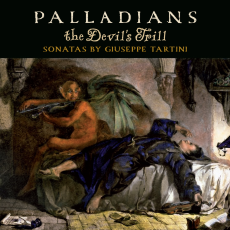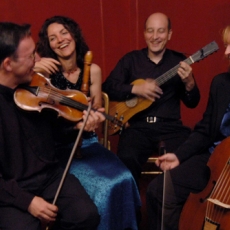Giuseppe Tartini - Palladians - International Record Review
The composer, theorist and violinist Giuseppe Tartini (1692 - 1770) was originally intended for the priesthood, but he followed up his initial studies by enrolling in law at Padua University, where he apparently spent most of the time practising his fencing. After marrying against his parents' wishes, he left Padua and took refuge in a monastery in Assisi, where he spent most of the time practising his violin. In 1721 he was appointed first violinist at the Basilica S. Antonio in Padua, a position he retained until his retirement in 1765. During this period he travelled widely, worked on his theoretical writing and established a violin school.
By contrast, the prodigious musical gifts of Francesco Maria Veracini (1690 - 1768), whose phenomenal violin playing had such a powerful effect on the young Tartini, left nobody in doubt as to where his future lay. After studies with his uncle Antonio Veracini, this proto-Paganini (who apparently said of himself ‘there is but one God and one Veracini') enjoyed enormous success in London, Dresden and indeed throughout Europe, ending his days as the (extremely wealthy) maestro di cappella to S. Pancrazio in Florence.
These two musicians could not have been more different, and yet both were supreme masters of their instruments. This new release from Palladians (formerly the Palladian Ensemble; the name change apparently reflects the flexibility of the ensemble, with players coming and going according to the requirements of the repertoire) gives listeners the opportunity to compare and contrast in the liveliest fashions.
Tartini's Devil's Trill Sonata, so-called because of a dream Tartini had wherein the devil played a sonata of truly diabolical complexity and the composer, upon waking, attempted to approximate it, is well known. Less so is the same composer's ravishing essay in programmatic music, Didone abbandonata, which Palladian William Carter, in his booklet notes, considers ‘an even more extraordinary achievement'. Both are included here, along with two exquisite slow movements from works written for the composer's friend, the cellist and bass viola player Antonio Vandini, and the Pastorale from Tartini's Op.1 brimming with rustic charm. Veracini is represented by a five-movement Sonata in A major from his Op.1, a real tour de force featuring lightning-fast scales and arpeggios, virtuoso bowing techniques and frequent multiple stopping - although even here there is respite in two gorgeous slow movements.
Violinist Rodolfo Richter again shows himself to be a worthy successor to Palladian's founding violinist, Rachel Podger. His technique seems to know no bounds; but more important is his ability to rely on suggestion and the listener's own imagination when necessary. This is as apparent in the darkly fantastic quality he brings to the final movement of The Devil's Trill Sonata as it is in the almost heart-breaking melancholy of the outer movements of Didone abbandonata. If he abandons himself to the sometimes maniacal ferociousness of Veracini's writing - the final Allegro of that composer's sonata is a knock-out - he also relishes with equal delight the more gentle bucolic charms of Tartini's Pastorale, as does Carter on Baroque guitar and Susanne Heinrich on viola da gamba.
Carter and Heinrich are excellent throughout, as is harpsichordist Silas Standage. Carter's deftly realized accompaniments (this time on archlute) can be heard to greatest advantage in the final movement of Didone abbandonata and in the D minor Grave from one of Tartini's viola concertos, written for Vandini; this last also allows the darker, expressive side of Heinrich's playing to be fully savoured. For his part, Standage's playing is highlighted in the Largo of the Veracini, where his sparkling skeins of sounds seem to caress Richter's delicate utterances with almost obscene affection.
The recorded sound is up to Linn's own usual high standard, while Carter's entertaining booklet notes are a pleasure to read. Long live Palladians!

